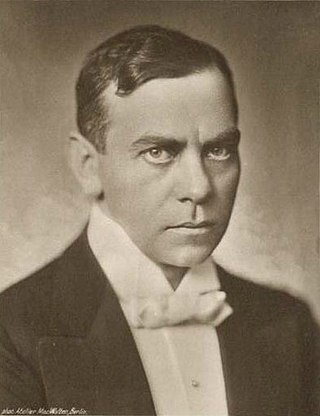Related Research Articles

Gustav Friedrich Fröhlich was a German actor and film director. He landed secondary roles in a number of films and plays before landing his breakthrough role of Freder Fredersen in Fritz Lang's 1927 film Metropolis. He remained a popular film star in Germany until the 1950s.

Otto Karl Robert Wernicke was a German actor. He is best known for his role as police inspector Karl Lohmann in the two Fritz Lang films M and The Testament of Dr. Mabuse.

Karl Hartl was an Austrian film director.
Max Wilhelm Kimmich, also known as M. W. Kimmich, was a German film director and screenwriter during the first half of the 20th century. He was the brother-in-law of Nazi Propaganda Minister Joseph Goebbels.
Erich Adolf Dunskus was a German film actor. He appeared in 170 films between 1927 and 1966. He was born in Pillkallen, East Prussia and died in Hagen, Germany.

Robert Le Vigan, was a French actor.

Gerhard Dammann was a German film actor.
Günther Krampf was an Austrian cinematographer who later settled and worked in the UK. Krampf has been described as a "phantom of film history" because of his largely forgotten role working on a number of important films during the silent and early sound era. Only two of Krampf's films The Student of Prague (1926) and The Ghoul (1933) were expressionist, as he generally used a naturalistic style.

Karl Ritter was a German film producer and director responsible for many Nazi propaganda films. He had previously been one of the first German military pilots. He spent most of his later life in Argentina.

Curt Courant was a German cinematographer who worked on over a hundred films during the silent and early sound eras. Courant worked in several European countries, collaborating with figures such as Alfred Hitchcock and Fritz Lang. As he was of Jewish ancestry, Courant was forced to leave Germany in 1933 and go into exile following the Nazi takeover of power. Courant worked at several of the leading British studios during the mid-1930s. He was the uncle of Willy Kurant who also became a cinematographer.
Victor Arménise was an Italian cinematographer. Arménise worked on over eighty feature films during his lifetime. He began his career working on Italian silent films. He later made films in several other countries including Britain and Germany but primarily in France. He worked with a number of leading directors including Raoul Walsh and Maurice Tourneur.
Willi Schur was a German actor and singer. He appeared in roughly ninety feature films in a variety of supporting roles.
Leo Leux was a German composer of film scores. He began working on films during the Weimar Republic, following the introduction of sound films. During the Nazi era, Leux worked largely on entertainment films such as Truxa (1937) as well more ideogically-oriented films such as Venus on Trial (1941). He continued to work in cinema following World War II, right up to his death in 1951.
Jacques Colombier (1901–1988) was a French art director who designed the sets for many films during his career.
Mady Berry was a French stage and film actress.
Marcel Lattès was a French composer of film scores. He worked in French cinema during the 1930s. In 1940 following the German defeat of France, the Jewish Lattès was interned before being moved to Auschwitz Concentration Camp and killed.

Peter Bosse was a German film actor. The son of actress Hilde Maroff, he appeared as a child actor in a number of Nazi era films during the 1930s. Later he often worked as a narrator in the post-war era.

The Mysterious Mister X is a 1936 German comedy film directed by J.A. Hübler-Kahla and starring Ralph Arthur Roberts, Annemarie Steinsieck and Herti Kirchner.
Arnold Lippschitz (1901–1952) was a German screenwriter. Born the son of the playwright Arthur Lippschitz, his young brother was the art director Herbert Lippschitz. He began his film career in 1918 at the end of the First World War. Of Jewish background, he fled Nazi Germany going on to work in the French film industry where he was credited as Arnold Lipp, working among other films on Yoshiwara (1937) by Max Ophüls. Following the German invasion of France he emigrated to America, working in Hollywood where he was credited as Arnold Phillips.